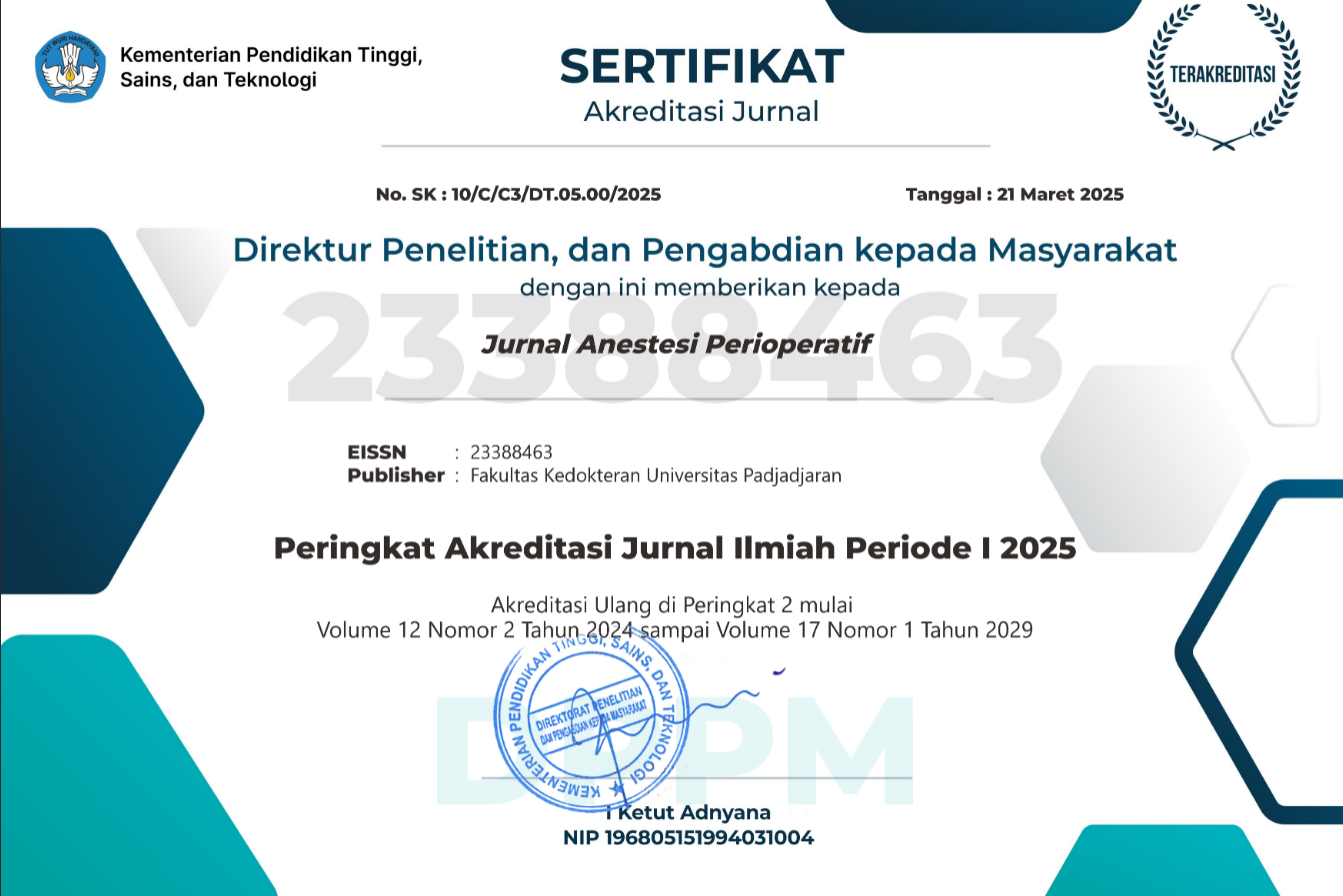Efektivitas Oksigenasi dan Ventilasi Saat Induksi Anestesi Umum Menggunakan Masker Bedah Dinilai berdasar atas SpO2 dan EtCO2
Abstract
Anestesiolog memiliki risiko tinggi terpapar aerosol pada saat melakukan tindakan ventilasi maupun intubasi. Anestesiolog harus dapat melakukan ventilasi dengan baik selama induksi anestesi umum. Tujuan penelitian ini adalah mengetahui efektivitas oksigenasi dan ventilasi saat induksi anestesi umum pada pasien yang menggunakan masker bedah dinilai berdasar atas SpO2 dan EtCO2. Penelitian ini merupakan penelitian analisis numerik berpasangan dengan rancangan eksperimental pada pasien yang dilakukan operasi elektif dengan anestesi umum di Instalasi Bedah Sentral RSUP Dr. Hasan Sadikin Bandung pada bulan November–Desember 2020. Selama induksi anestesi, pasien menggunakan masker bedah kemudian dilakukan penilaian SpO2 dan EtCO2 pada saat sebelum induksi dan selama induksi menit ke-1, 2, dan 3. Hasil penelitian mengungkapkan nilai SpO2 dan EtCO2 preinduksi dan pada menit ke-1, 2, dan 3 diperoleh nilai rerata SpO2 dan EtCO2 induksi menit ke-1, ke-2, dan ke-3 tidak lebih inferior dibanding dengan nilai pra induksi (p<0,05) dengan nilai rerata SpO2 dan EtCO2 dalam batas normal.Simpulan penelitian adalah penggunaan masker bedah selama induksi tidak mengurangi efektivitas oksigenasi dan ventilasipada pasien yang dilakukan anestesi umum dinilai berdasar atas SpO2 dan EtCO2.
Effectiveness of Oxygenation and Ventilation During General Anesthesia Induction Using Surgical Mask Assessed by SpO2 and EtCO2
Anesthesiologist have high risk for exposure of aerosol during ventilation or intubation. They must do ventilation during induction of general anesthesia effectively. The study was aimed to know how effective the oxygenation and ventilation during induction of general anesthesia while using surgical mask assessed by SpO2 and EtCO2. The research was a numerical analytic with experimental design performed on elective surgery patients done by general anesthesia in central operating theatre Dr. Hasan Sadikin General Hospital Bandung in November–December 2020. During induction of anesthesia, patient were using surgical mask and assessment of SpO2 and EtCO2 was done before induction and during induction in the 1st, 2nd, and 3rd minute induction. The result of the study revealed SpO2 and EtCO2 preinduction and 1st, 2nd, and 3rd minute induction had SpO2 and EtCO2 value in 1st, 2nd, and 3rd minute induction not inferior to pre induction value, with SpO2 and EtCO2 value within normal limit.The study has concluded that using surgical mask during induction does not decrease the effectiveness of oxygenation and ventilation in patient with general anesthesia assessed by SpO2 and EtCO2.
Keywords
Full Text:
PDFReferences
Bielicki JA, Duval X, Gobat N, Goossens H, Koopmans M, Tacconelli E, dkk. Monitoring approaches for health-care workers during the COVID-19 pandemic. Lancet Infec dis. 2020;395(2):1225–8.
He X, Lau EHY, Wu P, Deng X, Wang J, Hao X, dkk. Temporal dynamics in viral shedding and transmissibility of COVID-19. Nat Med. 2020;26(5):672–5.
Zheng L, Wang X, Zhou C, Liu Q, Li S, Sun Q, dkk. Analysis of the infection status of the health care workers in Wuhan during the COVID-19 outbreak: a cross-sectional study. Clin Inf Dis. 2020;92(2):401–2.
Cook TM. Personal protective equipment during the coronavirus disease (COVID) 2019 pandemic: a narrative review. Anaesthesia. 2020;75(7):920–7.
Ing EB, Xu Q (A), Salimi A, Torun N. Physician deaths from corona virus (COVID-19) disease. Occu Med. 2020 May 15;70(5):370–4.
Morcuende M, Guglielminotti J, Landau R. Anesthesiologists’ and intensive care providers’ exposure to COVID-19 infection in a New York City academic center: a prospective cohort study assessing symptoms and COVID-19 antibody testing. Anesth Analg. 2020;10(4):124–30.
Park JW, Min BH, Park SJ, Kim BY, Bae S il, Han SH, dkk. Midazolam premedication facilitates mask ventilation during induction of general anesthesia: a randomized clinical trial. Anesth Analg. 2019;129(2):500–6.
Warters RD, Szabo TA, Spinale FG, DeSantis SM, Reves JG. The effect of neuromuscular blockade on mask ventilation. Anaesthesia. 2011;66(3):163–7.
Jubran A. Pulse oximetry. Crit Care. 2015;19(1):272.
Aminiahidashti H, Shafiee S, Zamani Kiasari A, Sazgar M. Applications of end-tidal carbon dioxide (ETCO2) monitoring in emergency department: a narrative review. Emerg (Tehran). 2018;6(1):134–40.
Paal P, Falk M, Sumann G, Demetz F, Beikircher W, Gruber E, dkk. Comparison of mouth-to-mouth, mouth-to-mask and mouth-to-face-shield ventilation by lay persons. Resuscitation. 2006;70(1):117–23.
Shein SL, Whitticar S, Mascho KK, Pace E, dkk. The effects of wearing facemasks on oxygenation and ventilation at rest and during physical activity. PLOS ONE. 2021;16(2):e0247414.
Oberg T, Brosseau LM. Surgical mask filter and fit performance. Am J Infect Control. 2008;36(4):276–82.
Rengasamy S, Shaffer R, Williams B, Smit S. A comparison of facemask and respirator filtration test methods. Occupat Environment Hygiene. 2017;14(2):92–103.
Butterworth JF, Mackey DC, Wasnick JD, penyunting. Airway management. Morgan & Mikhail’s clinical anesthesiology. Edisi ke-5. New York: The McGraw-Hill Companies; 2013.
Jo T, Inomata M, Takada K, Yoshimura H, Tone M, Awano N, dkk. Usefulness of measurement of end-tidal CO2 using a portable capnometer in patients with chronic respiratory failure receiving long-term oxygen therapy. Intern Med. 2020;59(14):1711–20.
DOI: https://doi.org/10.15851/jap.v9n2.2401
Article Metrics
Abstract view : 1909 timesPDF - 1034 times
This Journal indexed by

JAP is licensed under a Creative Commons Attribution-NonCommercial 4.0 International License
View My Stats



